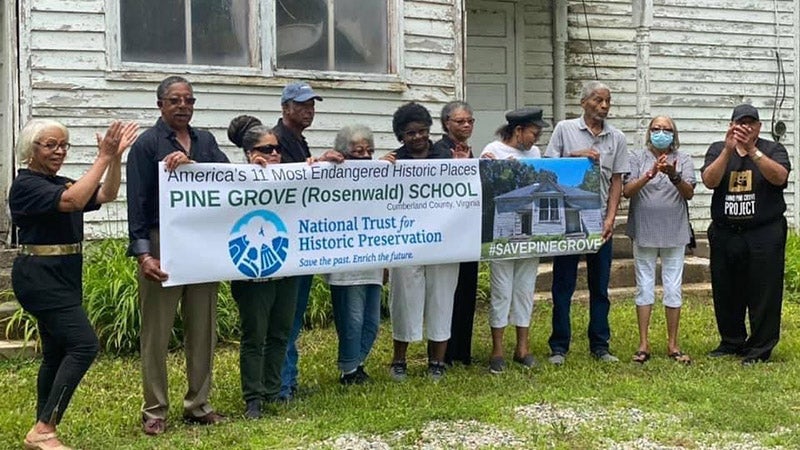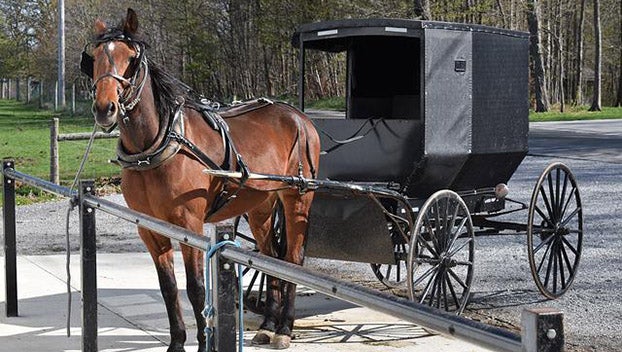Pine Grove named an endangered site
Published 8:31 am Tuesday, June 8, 2021

- Former Pine Grove students stand together to unveil the banner declaring Pine Grove Elementary School in Cumberland as one of the top 11 most endangered historic sites in America. From left are Muriel M. Branch, Alfred L. Austin, Austina Johnson Hume, W. Bruce Tate, Fannie H. Robinson, Dorothy M. Rice, Robin A. Stocks, Mary “Vicky” Morton, Lloyd James, Diane M. Watson and Michael D. Scales.
|
Getting your Trinity Audio player ready...
|
The Pine Grove Elementary School in Cumberland County has been recognized by the National Trust for Historic Preservation as one of the most endangered historic places in the country.
In a Thursday, June 3, press release, the trust announced Pine Grove is on its 2021 list of America’s 11 Most Endangered Historic Places.
One of the few remaining Rosenwald Schools originally established in rural communities throughout the South in order to educate African American children, Pine Grove is considered endangered due to the threat of the proposed Green Ridge Recycling and Disposal Facility to be built adjacent to the school.
Officials said the landfill site, “will fundamentally change the historic character of this 100-year-old community and put residents at risk from major environmental hazards.”
“Over 100 years ago, the parents of Pine Grove raised funds to build a school so their children could have access to a good education, and the elementary school they built became the center of the community. Today the descendants of those families are battling to protect this special place from construction of a nearby landfill,” Katherine Malone-France, chief preservation officer for the National Trust for Historic Preservation, was quoted in the release. “Pine Grove Elementary tells the story of a community fighting, repeatedly and against all odds, to provide a better future for their children, and its continued preservation would be a victory for social and environmental justice.”
Thursday morning, members of the Agee Miller Mayo Dungy (AMMD) Pine Grove Project, an organization that seeks to protect and preserve the legacy of Pine Grove, gathered together at the school along with 11 former Pine Grove students and many community partners in order to celebrate the National Trust for Historic Preservation’s announcement.
The event included a variety of guest speakers, music and poetry, and a banner declaring the Pine Grove site as one of the trust’s 11 most endangered historic places was unveiled during the ceremony.
Those present at Thursday’s celebration were encouraged to follow the famous words of abolitionist Frederick Douglass, “Agitate, agitate, agitate.”
“As a farm girl growing up in the Pine Grove community in the 1940s and 1950s, I observed my dad plowing ‘new ground’ each spring,” AMMD Pine Grove Project President and former Pine Grove student Muriel Miller Branch said. “That spring ritual meant that he had to agitate the ground, tear through roots and earth in order to plant a new crop. In much the same way, members and allies of AMMD Pine Grove Project have become plowers, agitating for racial, social and environmental justice and equity in the preservation of Black historic resources … Being placed on the National Trust’s 11 Most Endangered Historic Places has given AMMD Pine Grove Project a larger plow with which to agitate, unearth and tear up the status quo in order to plant equity — to confront where toxic industries are placed and who gets to tell our stories.”
“As I listened to Muriel and other Pine Grove students, I came to understand that the construction of a mega-landfill risked causing significant harm not just to the school – but to the deep, rich and vibrant history of Black life in Cumberland County,” UVA Environmental Law and Community Engagement Clinic Director Cale Jaffe said. “ So let’s make sure we appreciate the historic significance of the Pine Grove School in context. The African-American historic and cultural resources here extend far beyond the four walls of Pine Grove School building itself. It is critically important to take into account the whole resource — not just the physical structure of the Pine Grove School — but the historic community of which it was the center.”
“There is a troubling, widely-held belief that ‘rural economic growth’ means constructing more detention centers and landfills,” Justin Reid, manager of the Virginia General Assembly African American Cultural Resources Task Force and director of community initiatives for Virginia Humanities, said. “We have to move beyond this short-sighted thinking. The greatest economic resource in our communities, besides hardworking, talented people, is our cultural and natural heritage — places like Pine Grove, as well as long-held traditions like hunting, hiking, fishing and boating. Mega-landfills not only threaten this way of life; they also threaten future economic opportunities and investment. Cumberland County residents need and deserve an innovative, longer-term vision that promotes smart growth and sustainable development.”





